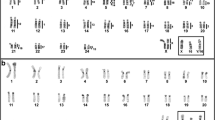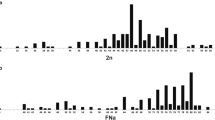Abstract
A study was made of the organization of the chromosome orthologous to HSA16 in primates using a panel of 8 BAC probes spanning human chromosome 16. The probes were used in FISH experiments on great apes and on representatives of the Old World monkeys, New World monkeys, and lemurs. The domestic cat was used as an outgroup. The results indicate that 16p and 16q were separate chromosomes in a primate ancestor. They fused in a Catarrhini ancestor giving rise to the present day form found in HSA, great apes, and Old World monkeys. Several rearrangements were found in New World monkeys.
Similar content being viewed by others
References
Bailey JA, Gu Z, Clark RA et al. (2002) Recent segmental duplications in the human genome. Science 297: 1003-1007.
Bigoni F, Koehler U, Stanyon R, Ishida T, Wienberg J (1997) Fluorescence in situ hybridization establishes homology between human and silvered leaf monkey chromosomes, reveals reciprocal translocations between chromosomes homologous to human Y/5, 1/9, and 6/16, and delineates an X1X2Y1Y2/X1X1X2X2 sex-chromosome system. AmJ Phys Anthropol 102: 315-327.
Carbone L, Ventura M, Tempesta S, Rocchi M, Archidiacono N (2002) Evolutionary history of chromosome 10 in primates. Chromosoma 111: 267-272.
Cardone MF, Ventura M, Tempesta S, Rocchi M, Archidiacono N (2002) Analysis of chromosome conservation in Lemur catta studied by chromosome paints and BAC/PAC probes. Chromosoma 111: 348-356.
Finelli P, Stanyon R, Plesker R, Ferguson-Smith MA, O'Brien PC, Wienberg J (1999) Reciprocal chromosome painting shows that the great difference in diploid number between human and African green monkey is mostly due to non-Robertsonian fissions. Mamm Genome 10: 713-718.
Johnson ME, Viggiano L, Bailey JA et al. (2001) Positive selection of a gene family during the emergence of humans and African apes. Nature 413: 514-519.
Moore CM, Janish C, Eddy CA, Hubbard GB, Leland MM, Rogers J (1999) Cytogenetic and fertility studies of a rheboon, rhesus macaque (Macaca mulatta) x baboon (Papio hamadryas) cross: further support for a single karyotype nomenclature. Am J Phys Anthropol 110: 119-127.
Murphy WJ, Stanyon R, O'Brien SJ (2001). Evolution of mammalian genome organization inferred from comparative gene mapping. Genome Biol (http://genomebiology.com) 2(6): REVIEWS0005.1-0005.8.
Sherlock JK, Griffin DK, Delanthy JDA, Parrington JM (1996) Homologies between human and marmoset (Callitrix Jacchus) chromosomes revealed by comparative chromosome painting. Genomics 33: 214-219.
Stanyon R, Consigliere S, Muller S, Morescalchi A, Neusser M, Wienberg J (2000) Fluorescence in situ hybridization (FISH) maps chromosomal homologies between the dusky titi and squirrel monkey. Am J Primatol 50: 95-107.
Wienberg J, Stanyon R, Jauch A, Cremer T (1992) Homologies in human and Macaca fuscata chromosomes revealed by in situ suppression hybridization with human chromosome specific libraries. Chromosoma 101: 265-270.
Yunis JJ, Prakash O (1982) The origin of man: a chromosomal pictorial legacy. Science 215: 1525-1530.
Author information
Authors and Affiliations
Corresponding author
Rights and permissions
About this article
Cite this article
Misceo, D., Ventura, M., Eder, V. et al. Human chromosome 16 conservation in primates. Chromosome Res 11, 323–326 (2003). https://doi.org/10.1023/A:1024087823030
Issue Date:
DOI: https://doi.org/10.1023/A:1024087823030




